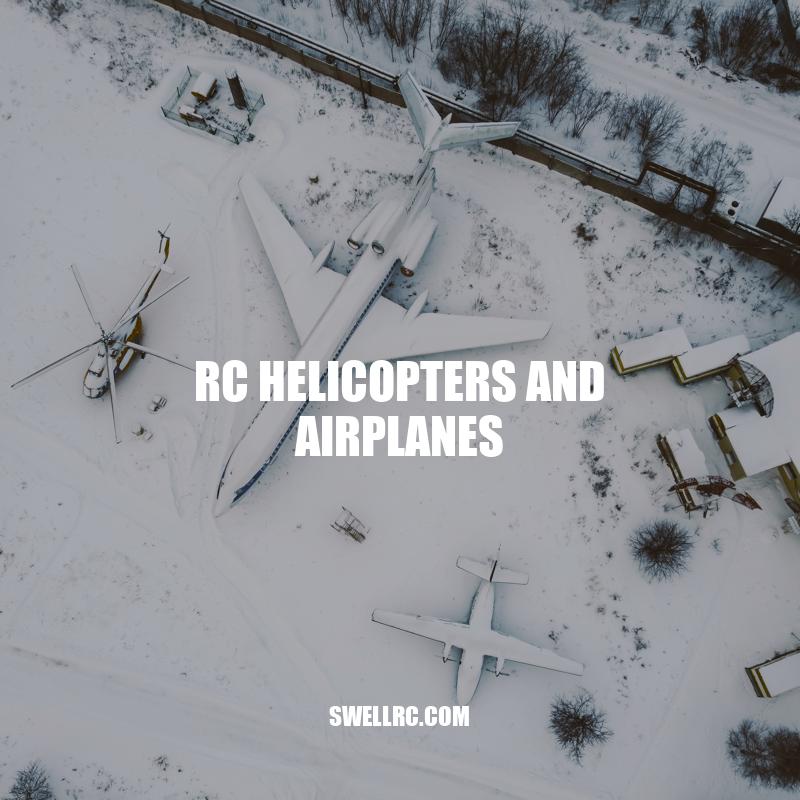Mastering RC Helicopters and Airplanes: A Beginner’s Guide
Remote-controlled helicopters and airplanes are a fascinating and enjoyable hobby that has been growing in popularity over the past few years. They provide hours of entertainment for kids and adults alike, as well as a unique challenge for those interested in mastering the art of flight. With the advancement of technology, the range of RC helicopters and airplanes has expanded, providing a wide range of options to choose from. RC helicopters come in various types, such as single rotor, coaxial, and multirotor, each of which has its own advantages and disadvantages. Similarly, RC airplanes are available in different models, including trainer, aerobatic, and glider. Regardless of which type or model one chooses, there are essential components and features that are necessary for their proper functioning, such as the transmitter, receiver, servos, and gyro. Learning the basics of flying these remote-controlled machines is critical, as it can be challenging to control them. Thus, practicing regularly and using safety measures is necessary. In this article, we will delve further into the world of RC helicopters and airplanes, discussing the different types and models available, their components, flying techniques, and maintenance tips, among other essential aspects.
Types of RC Helicopters and Airplanes
When selecting an RC helicopter or airplane, the type and model suitable for a particular individual should be considered. Each one has its pros and cons and requires a particular skill level to operate. Here are some of the types available:
- Single Rotor: These are the most commonly used remote-controlled helicopters, and they have a single main rotor and tail rotor. They provide better maneuverability than other types and can perform various stunts and tricks.
- Coaxial Rotor: This type of helicopter has two rotors that spin in opposite directions, which provides excellent stability and controls. They are commonly used for indoor flying and learning purposes.
- Multirotor: They possess multiple rotors that can range from three to eight, depending on the model. They offer better stability but require a higher skill level to operate successfully than single rotor helicopters.
- Trainer Airplanes: This type of airplane is designed for beginners and is easy to operate. They are forgiving and can withstand crashes.
- Aerobatic Airplanes: For individuals who enjoy performing stunts and tricks, aerobatic airplanes are the right choice. However, they require a higher skill level to operate than trainer airplanes.
- Glider Airplanes: Glider airplanes can stay airborne for an extended period without a motor, making them ideal for long distance flying or gaining altitude.
Apart from the types listed above, there are numerous other types of RC helicopters and airplanes available in the market. You can go through the manufacturer’s website or online retailers to see the different models available.
What is easier to fly RC helicopter or plane?
When it comes to flying an RC aircraft, whether a helicopter or a plane, both require a certain level of skill. However, some experts suggest that planes are typically easier to fly than helicopters. Planes are built to be more stable and have a simpler control system, which can be easier for beginners.
If you’re interested in learning more about flying RC planes or helicopters, there are a lot of resources available online. Websites such as RCGroups.com and RCUniverse.com offer forums and articles where you can ask questions, find tutorials and reviews of products, and connect with other enthusiasts. If you’re looking for a beginner-friendly RC plane, the HobbyZone Sport Cub S2 is a popular choice, while the Blade 70S or E-flite Nano S2 are great options for those interested in learning to fly an RC helicopter.
Components and Features
To operate an RC helicopter or airplane, various essential components and features must be present and function properly. These components and features include:
- Transmitter: This is the device used to control and maneuver the RC helicopter or airplane from a distance. They come in different types and vary in features and price.
- Receiver: This device receives the signals transmitted by the transmitter and sends them to the servos to control the RC helicopter or airplane.
- Servos: These are devices that move the control surfaces (e.g., ailerons, elevators, and rudders) and are controlled by the receiver. They are essential for controlling the RC helicopter or airplane.
- Gyro: Gyros control the stability of the RC helicopter or airplane. They help to keep the device flying level when there are strong winds.
- Battery: The battery is what powers the device. It determines the length of time the RC helicopter or airplane can stay in the air.
- Motor: The motor powers the rotors or propellers that make the device fly. Electric, nitro, and gas-powered engines are available for different models.
With time and frequent use, some components will deteriorate and require upgrading or replacement. Knowing how to maintain and upgrade components is essential to ensure the longevity and optimal performance of your RC helicopter or airplane. You can visit various RC hobbyist websites to learn more about the different components, their functions, and how to upgrade or replace them.
Here’s a comparison table of some of the most popular RC helicopter and airplane batteries:
| Battery Type | Voltage | Capacity (mAh) | Discharge Rate (C) |
|---|---|---|---|
| Lithium Polymer (LiPo) | 3.7V to 22.2V | 100mAh to 5,000mAh | 20C to 90C |
| Nickel Cadmium (NiCd) | 1.2V | 400mAh to 5,000mAh | 10C to 35C |
| Nickel-Metal Hydride (NiMH) | 1.2V | 500mAh to 5,000mAh | 5C to 20C |
To learn more about RC helicopters and airplanes, you can check out some of the top RC hobbyist websites, Horizon Hobby and RC Groups. These websites offer a wide range of RC products, tutorials, and forums where you can connect with other hobbyists and learn more about the hobby.
What are the controls of RC helicopter?
The controls of an RC helicopter are typically located on the remote control device and include the following:
- Throttle: Controls the upward and downward motion of the helicopter.
- Pitch cyclic: Controls the forward, backward, left, and right movement of the helicopter.
- Yaw: Controls the helicopter’s rotation or turning left or right movements.
- Collective Pitch: Used to adjust the pitch angle of the helicopter’s main rotor blades to control vertical movement.
- Tail rotor: Controls the direction of the helicopter’s tail and keeps it from spinning uncontrollably.
It’s important to note that different RC helicopters may have slightly different controls. Some models may also have additional controls, such as camera control or LED lights.
If you are a beginner interested in RC helicopters, several websites offer guides and tutorials on how to operate them effectively, including Horizon Hobby, RC Helicopter Fun, and RC Groups. There are also various RC helicopter models available for purchase on websites like Amazon and HobbyKing.
Flying Tips and Techniques
RC helicopters and airplanes are exciting hobbies that require practice and patience. Here are some basic flying tips and techniques to help you get started:
- Before flying, check the local regulations for RC flying. Look for an open flying area away from people, buildings, and power lines.
- Start with a beginner-level RC helicopter or airplane with low wing loading to learn the basic flying techniques.
- Begin by taking off and landing the device in an open area with no obstacles.
- Practice hovering, flying straight, and flying in circles while keeping the device within your sight.
- Learn the basics of controlling the device and maintaining altitude, speed, and direction.
- Gradually learn more advanced flying techniques such as diving, loops, and flips.
- Practice makes perfect! It’s important to fly regularly and improve your flying skills over time.
- Safety is paramount. Always stay clear from wildlife, people, and high traffic areas.
RC helicopters and airplanes are fun, but accidents do happen. Therefore, it’s essential to learn basic maintenance and repair skills to keep your device in optimal condition. Many hobbyist websites offer tutorials and instructions on how to maintain and repair RC devices. Check out RC Groups or RC Forums to connect with other hobbyists and learn from their experiences.
As technology advances, the features and capabilities of RC helicopters and airplanes continue to evolve. Head over to popular hobbyist websites to discover innovative products, such as those with built-in cameras that allow you to photograph or record while you fly. You can also find RC simulators that you can use to develop and improve your flying skills without risking the device.
Happy flying!
What helps with first time flying?
For first-time flyers, there are several things that can help ease anxiety and make the experience more comfortable.
- Check-in online and arrive at the airport early to avoid feeling rushed.
- Wear comfortable clothing and shoes, and pack essential items in a carry-on bag.
- If you experience motion sickness, talk to your doctor about medication options.
- During the flight, take frequent walks up and down the aisle to stretch and move around.
- Use noise-cancelling headphones to block out the sounds of the plane and reduce stress.
- Breathing exercises or meditation apps can help with anxiety during takeoff and landing.
Several websites, such as AirHelp and SeatGuru, provide additional tips for first-time flyers and offer resources for navigating the airport and airline experience. Additionally, travel products like neck pillows and compression socks can provide added comfort during the flight.
Maintenance and Repair
Maintaining and repairing your RC helicopter or airplane is just as important as learning to fly it. Basic maintenance and regular checks will help prevent damage, extend the life of your device, and ensure it is always ready for flight. Here are some maintenance and repair tips for your RC helicopter or airplane:
- Inspect the device before and after each flight. Look for cracks, fatigue, or damage to the rotor blades, fuselage, or electronic components.
- Check the battery and ensure it is in good condition and fully charged.
- Keep the device clean and dry. Avoid moisture or humidity as they can damage the electronic components.
- Store your RC helicopter or airplane in a cool, dry place and protect it from dust and debris.
- If your device requires repair, consult the user manual or reach out to a professional technician to prevent further damage.
You can also find many tips and tutorials online on how to maintain and repair your RC helicopter or airplane, from simple fixes to more complex repairs. However, keep in mind that some repairs may require specialized tools, so make sure you have the necessary tools or seek professional help if needed.
As a beginner, it’s important to take the time to learn the basics of flying and maintaining an RC helicopter or airplane. By following the tips and techniques outlined in this article, you can become a proficient pilot and maintain your device in optimal condition.
Remember, flying RC devices is not just a hobby but a passion that requires patience, dedication, and a willingness to learn. With practice and proper maintenance, your RC helicopter or airplane can provide you with endless hours of fun and adventure.



